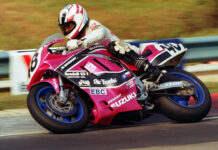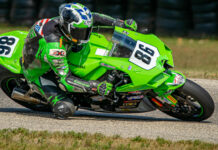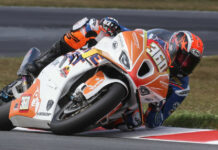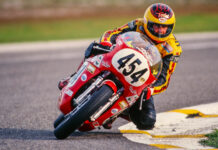Daytona Superbike Equipment Regulations All machines eligible for participation in Daytona Superbike must be approved by AMA Pro Racing and homologated by the manufacturer or sanctioning body. Machines currently eligible for homologation by their manufacturer or distributor for competition in 2009 are: Aprilia Tuono BMW HP2 Sport Buell 1125R Ducati 848 Ducati S4R Honda CBR600RR Kawasaki Ninja ZX-6R KTM Super Duke MV Brutale 910S Suzuki GSX-R600 Triumph Daytona 675 Yamaha YZF-R6 Each homologated machine will have a published Technical Information Form (TIF) containing the AMA approved specifications required for competition. Specifications will include, but not be limited to make, model, year, original displacement, and special allowances (if any) for this specific homologated machine. The original TIF may be modified to enhance or reduce the performance of the machine based upon actual competition experience. Unless otherwise specified, all parts must originate from the same make/model as the homologated machine, meaning no up-dating or back-dating is permitted 1. HORSEPOWER AND WEIGHT LIMITS A. Minimum weight is 360 lbs in the exact condition the machine finishes any competition activity (qualifying or race final) without the addition of fluids or other items of any kind. B. Once the machine weight has been established, the motorcycle will be tested for power output on the official series dynamometer. Power is limited to one (1) horsepower for every three (3) pounds of machine weight, up to a maximum of 140 horsepower. Fuel may be added to allow for the dynamometer testing after the official weight has been recorded. C. In no case may more than 25 lbs of ballast be added to any machine, said ballast to be added/fastened in accordance with approved mounting procedures. D. If necessary, specific motorcycles may be allowed a variance from the standard power to weight ratio to ensure parity in competition. Where such variances are allowed, they will be published on the TIF for the machines affected. E. Combined motorcycle and rider weights will be used to determine power limits starting in the 2010 season. 2. TIRES A. XXXXXX is the Official Tire of AMA Pro Road Racing and only tires produced by XXXX and mounted at the meet may be used in competition. B. The number of available compounds, configurations, and quantities available for use at each event will be announced coincident with the announcement of the Official Tire of the series and may be altered during the course of the 2009 season per safety, wear and related experience. 3. FUEL A. Official Fuel – The Official Fuel of AMA Pro Racing is XXXXXXXX and its exclusive use in unadulterated form shall be mandatory. B. Only air may be mixed with the fuel as an oxidant, and no other substances, chemicals and/or liquids whatsoever shall be added, combined, mixed and/or introduced to said Official Fuel whether intentionally or unintentionally unless approved in advance in writing by the AMA for use by all competitors. C. All competitors must use the official fuel, as supplied by the manufacturer at the track, during all on-track sessions. D. All motorcycles must prominently display the appropriate unmodified official fuel company decal on the motorcycle at all times. E. AMA Pro Racing has the right to sample a competitor’s fuel at any time. F. Competitors are responsible for the safe and proper handling and security of their fuel from when it is dispensed to them until it is used. G. Competitors are responsible for properly disposing of all unused fuel. 4. WHEELS/BRAKES A. Original equipment wheels must be used, except where a TIF provides for substitutes. Substitutes must appear on the Eligible Equipment List. (1) Front wheels = 17″ x 3.5″ all machines (2) Rear wheels = 17″ x 5.5″ or 17″ x 6″ B. Original equipment brake calipers must be used, except where a TIF provides for substitutes. Substitutes must appear on the Eligible Equipment List. C. Aftermarket brake pads and lines may be substituted by homologated units appearing on the Eligible Equipment List. D. The brake master cylinders may be substituted by homologated units appearing on the Eligible Equipment List. E. With approval of the Technical Inspector, front wheel spacers may be made “captive”. F. With approval of the Technical Inspector, rear wheel spacers may be made “captive”, and a caliper retaining device may be used. Chain adjuster must be OEM. 5. FRONT SUSPENSION A. Original front forks must be retained, including inner and outer tubes, fork bottoms, caliper mounts, axles and spacers. B. Aftermarket Cartridge kits appearing on the Eligible Equipment List are permitted and aftermarket fork caps may be substituted. C. A steering damper may be installed with a homologated unit appearing on the Eligible Equipment List. D. A fork brace may be installed with a homologated unit appearing on the Eligible Equipment List. E. Triple Clamps may be substituted with a homologated unit appearing on the Eligible Equipment List. F. Front suspension modifications are limited to: (1) Internal parts may be modified consistent and within the foregoing restrictions, including substitution of springs, change of shims and/or spacers, and addition of kit/aftermarket valving units appearing on the Eligible Equipment List. (2) External Compression Adjusters may be modified/changed. (3) Steering Head inserts to adjust rake may be used as long as no part of the frame is modified. 6. REAR SUSPENSION A. The original model, stock swingarm must be retained, unchanged, except that the axle adjustment opening/slot may be lengthened, with the permission of the Technical Inspector. B. The rear shock linkage may be substituted with a homologated unit appearing on the Eligible Equipment List. C. The rear shock may be modified or replaced by units appearing on the Eligible Equipment List. 7. FRAME/ADJUSTABLE PIVOT A. Unless otherwise provided for on the TIF, the original frame must be used. Unnecessary brackets may be removed. B. Adjustable swingarm pivots are permitted, but no modifications to the frame or swingarm can be made to allow this adjustability. 8. BODYWORK/CONTROLS/APPEARANCE A. Aftermarket, OEM-style bodywork and custom fairing mounts may be used. B. The fairing must match the shape of the OEM machine in silhouette and profile and the AMA shall have the right to use templates and go-no-go devices therefor. 1) An oil retaining, “sealed” lower fairing is mandatory. C. The stock gas tank must be used, but aftermarket gas caps are allowed. D. A front fender must be mounted. E. Aftermarket footpegs, clip-on bars, shift/brake mechanisms and fasteners may be used. F. Non-standard “Kill Switches” must not be spring loaded and must be well marked. G. Titanium Fasteners are not permitted. H. Tail sections may be increased in size to allow for required number display. Final approval rests with the Chief Technical Inspector. (1) AMA Pro retains the right to require number plates on machines with small or unusually sized or shaped tail sections. I. Numbers must be a minimum of 8 inches high and in a clear contrasting color to the background area on which they are displayed. 9. ENGINE MODIFICATIONS A. Cylinder Head (1) No modifications are allowed except as follows: a. Cylinder head, cylinder and crankcase gasket surfaces only may be machined for increased compression. All other surfaces of the cylinder head, cylinder and crankcases must remain absolutely as homologated with no metal removal. b. Light cleaning of gasket surfaces with steel wool, Scotch-Brite®, etc. is permitted. Deburring radius of machined area must not be greater than 0.020 inches or 0.5mm. c. The cylinder head gasket may be changed. d. The valves, valve seats, guides, springs, tappets, oil seals, shims, cotter valve, spring base and spring retainers must be as originally produced by the manufacturer for the homologated machine. Valve spring shims are allowed. B. Camshaft (1) No modifications are allowed. (2) At the technical checks: for direct cam drive systems, the cam lobe lift is measured; for non direct cam drive systems (i.e. with rocker arms), the valve lift is measured. (3) The timing of the camshaft is free. C. Cam Sprockets (1) No dimensional modifications are allowed. (2) Cam sprockets may be slotted solely for the purpose of altering cam timing. (3) Press-on cam sprockets may be replaced with aftermarket steel bolt-on cam sprockets and adapters. (4) Aftermarket cam chain tensioners are permitted. D. Crankshaft (1) Crankshaft must remain as homologated with the following modifications allowed. (2) Balancing. This may only be achieved by the same method used by the OEM. For example, heavy metal (i.e. Mallory metal) inserts are not permitted unless they were originally specified by the OEM. (3) Bearing surfaces may be polished or surface treated. (4) Polishing and lightening of the crankshaft is not allowed. (5) Primary gears can not be changed or modified. (6) Oil galley plugs may be modified, removed or replaced. E. Oil Pumps and Oil Lines (1) No pump modifications are allowed. (2) Oil lines may be modified or replaced. Oil lines containing positive pressure, if replaced, must be of metal reinforced construction with swaged or threaded connectors. F. Connecting Rods (1) No modifications are allowed (including polishing and lightening). G. Pistons (1) No modifications are allowed (including polishing and lightening). H. Piston Rings (1) No modifications are allowed. I. Piston Pins and Clips (1) No modifications are allowed. J. Cylinders (1) No modifications are allowed except as provided for above. K. Crankcase and all other Engine Cases (i.e. ignition case, clutch case, etc.) (1) No modifications to the crankcases are allowed except as provided for above. (2) Lateral (side) covers may be altered, modified or replaced. If replaced, the cover must be made in material of same or higher specific weight and the total weight of the cover must not be less than the original one. (3) On motorcycles where lateral covers or engine cases contain oil, strengthened engine side covers or case guards must be installed. All such protection devices must weigh no less than the original homologated parts and must be approved by the AMA Pro Tech Inspector. L. Transmission/Gearbox (1) Kit-type Electronic “quick shifters” are allowed. (2) Manual “secondary” hand operated kill switch/quick shifters are not allowed. (3) Final drive system, if not by chain, may be modified to chain type, utilizing kits specified on the Eligible Equipment List. (4) Original equipment shift drum detent stars may be modified or replaced with approved, homologated aftermarket parts. (5) Other modifications to gearbox or selector mechanism are not allowed. M. Countershaft sprocket, rear wheel sprocket, chain pitch and size can be changed. (1) The sprocket cover can be modified. N. Stock carb bodies or stock fuel injection systems must be used, but carb internals, velocity stacks and injection management systems may be altered or replaced. O. Injectors must be stock and unaltered from the original specification and manufacture. P. Aftermarket exhaust systems appearing on the Eligible Equipment List may be installed. Q. “Dry Clutches” are only permitted when used on the equivalent OE production model. R. Aftermarket “Slipper” clutches appearing on the Eligible Equipment List are permitted. S. Homologated engine control unit (ECU), must be either: (1) As homologated and inner software can be changed; (2) Or the ECU kit model (produced and/or approved by the machine Manufacturer) can be used. (3) A special connector can be used to connect the kit ECU and the original wire loom. (4) Series provided Engine Control Units may be required in 2010 and beyond. 10. AIR BOX/INTAKE/SCOOPS A. Original equipment air box is required, without modification. B. An air filter is required. Original equipment air filter and air filters appearing on the Eligible Equipment List are permitted. C. Ram air systems are permitted if specified and used on the homologated motorcycle. Ducts and scoops, must be identical in specification to the original equipment system. 11. POST QUALIFYING/POST RACE TECH A. Immediately following each qualifying session or race, the top three finishers plus other motorcycles chosen at random at the discretion of the AMA will be tested on the Official Series Dynamometer to verify power. B. Other than the motorcycle’s throttle/twist grip, switches or any other device and/or methodology designed to and/or having the ability or potential to affect the horsepower readings during dynamometer testing are strictly prohibited. C. Any entrant, rider, crew member and/or entrant affiliate (who are not manufacturers of homologated motorcycles), who attempts to and/or does alter the performance of his/her/their machine following any competition event, in an effort to affect the dynamometer or weight results, will be disqualified from the meet and suspended from AMA Pro Road Racing participation for a period of no less than one year, and assessed a $50,000.00 fine which must be paid in full before reinstatement. A second offense will result in a lifetime ban for the offending entrant and/or entity. D. Any entrant, entrant affiliate and/or contractor who is/are manufacturers of homologated motorcycles, who attempts to and/or does alter the performance of its/their machine following any competition event, in an effort to affect the dynamometer or weight results, will be disqualified from the meet and suspended from AMA Pro Road Racing participation for a period of no less than one year, and assessed a $250,000.00 fine which must be paid in full before reinstatement. A second offense will result in a loss of approval for the homologated machine used in the meet where the offense took place, thereby rendering it ineligible for use by any and all entrants for a period of twelve (12) months. E. Machines unable to make post qualifying or post race tech and complete their dynamometer runs for any reasons, including major crashes or major mechanical failures will be penalized. Reasonable allowances may/will be made for minor mechanical failures that can be repaired, under strict supervision, in a reasonable amount of time and that do not have any bearing on performance or weight. Reasonable allowances may/will also be made for minor crashes on machines that can be ridden back to pit lane. Determination of ‘minor’ will be at the sole discretion of the Tech Inspector. F. In the instance where a motorcycle on the post-race dynamometer produces one run where that motorcycle registered within (but not more than) one horsepower in excess of the horsepower limit, that motorcycle will be re-tested at the end of that class/group, time allowing and at the request of the entrant. If that motorcycle again measures/tests any way in excess of the allowable horsepower limit , that machine will be penalized as per the Rule book. If that machine reads within the guidelines in the dynamometer re-do, no penalty will be assessed. G. Motorcycle weights will be checked immediately following qualifying or races, in the same condition in which they finish the activity, including all fluids such as oil, water and fuel. H. No fluid and/or any other item(s) may be added to the motorcycle prior to the determination of weight. Subsequent to official weight verification, fuel may be added for the purpose of completing the required dynamometer verification.
2009 AMA Pro Racing Daytona Superbike Rules
2009 AMA Pro Racing Daytona Superbike Rules
© 2008, Roadracing World Publishing, Inc.






